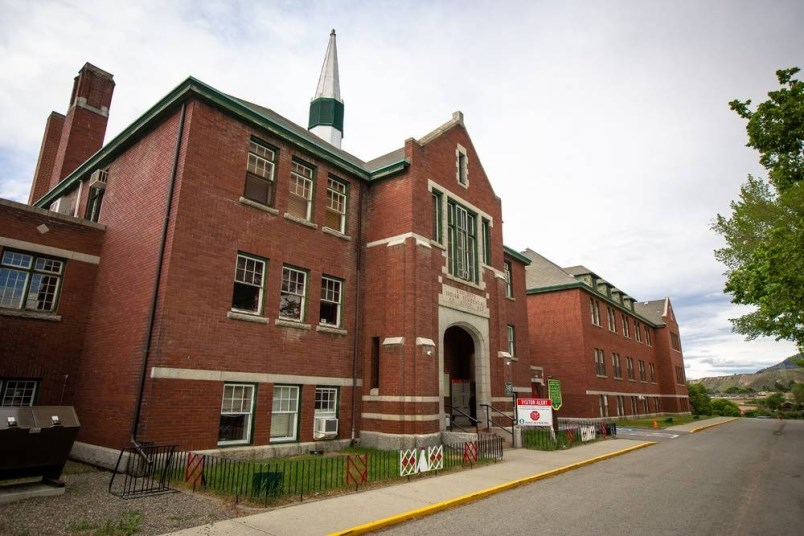B.C. officials announced the province’s restart plan, COVID-19 cases continued to drop, and the forecast called for actual sun and temperatures over 10 degrees.
All in all, the last week of May was shaping up to be a pretty good news week by pandemic standards.
It was, that is, until Thursday, May 27, when Tk’emlups te Secwepemc First Nation Chief Rosanne Casimir announced that the remains of 215 children, some as young as three, had been located in Kamloops, at the site of what was once Canada’s largest residential school. The unmarked grave was discovered using ground-penetrating radar. It confirms ”an unthinkable loss that was spoken about but never documented,” the Nation explained in a news release.
Worse yet? By all accounts, the discovery is the tip of the iceberg.
The Kamloops Indian Residential School was just one of more than 130 government-funded, church-run residential schools that operated in Canada between 1831 and 1996, with the sole purpose of eliminating students’ Indigenous identities. During this time, they ripped an estimated 150,000 children away from their communities.
The Truth and Reconciliation Commission of Canada (TRC) estimates that 6,000 students died while attending Canada’s residential schools. If that estimate is correct, it means the odds of students being killed at these schools was one in 25. For reference, the odds of a Canadian soldier dying in the Second World War were one in 26. Prime Minister Justin Trudeau last week called the finding of the remains in Kamloops “a painful reminder of that dark and shameful chapter of our country’s history.” His adjectives are right, but relegating them to a chapter of our history isn’t just incorrect, it’s insulting.
Words matter. He, other leaders, and non-Indigenous Canadian settlers need to call it what it is. It’s not history. It’s our present.
It wasn’t just a colonial policy, but a systematic, carefully-orchestrated genocide that the First Nations we share our country with are still reeling from.
Today, more than half of the children in foster care in Canada are Indigenous. Last year, more than 30 per cent of Canada’s inmate population was Indigenous, even though First Nations account for five per cent of Canada’s overall population.
An Indigenous person in Canada is more than 10 times more likely to have been shot and killed by a police officer in Canada since 2017 than a white person in Canada, according to a CTV News analysis last year. Sixty drinking water advisories remained in effect in 41 First Nations communities in Canada as of November 2020, according to CBC.
All this, while tens of thousands of residential school survivors are still alive.
We need to do more than wear orange shirts and fly flags at half-mast. (It’s the bare minimum, but the decision still took federal officials three full days to make.)
We need to enact every single call to action brought forward by the Truth and Reconciliation Commission of Canada in 2015. (A December 2019 study by the Yellowhead Institute said just nine of 94 calls to action have been completed.)
The Catholic Church needs to formally apologize and admit fault for the atrocities that took place in residential schools. (After Pope Francis refused a direct appeal for such an apology from Trudeau three years ago.)
We can recognize the progress we’ve made since the last residential school closed while recognizing that there is so much more to do.
The timing of this news feels almost ironic, as June marks National Indigenous History Month in Canada.
It makes me wonder what contributions those 215 souls would have made to history. What could they have accomplished if they were supported and encouraged to celebrate their culture?
Indigenous Peoples are more than the multigenerational trauma that we continue to inflict upon them. Despite our country’s best attempts at cultural genocide, their traditions survived and should be valued. First Nations’ collective connection to the land, in particular, is something we could all stand to learn from these days.
This National Indigenous History Month, my aim is to grieve those 215 lives—plus the thousands of others we already knew about—by educating myself: by reading Truth and Reconciliation Commission of Canada reports and re-reading the Indian Act, by truly confronting the horrors that happened at residential schools. But more than that, my hope is to learn more about Indigenous history before we stepped in: the traditions that residential schools were trying so hard to erase.
A 24-hour National Indian Residential School Crisis Line is available at 1-866-925-4419 to provide emotional support and crisis referral services to former residential school students and others affected.





